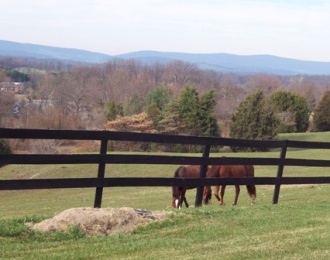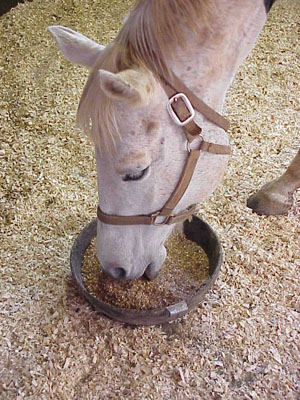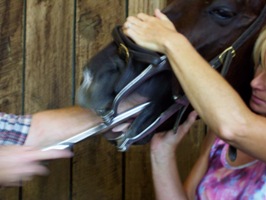Health Care for Horses
Thoughtful and planned care will allow your horse to live a longer and healthier life. Good equine husbandry is based upon the principle of preventive care — problem prevention rather than problem treatment. This requires embracing all aspects of horse care that affect its health and well-being. The purpose of this publication is to provide broad overview of health care for horses. More detailed information is available through your local extension agent and/or veterinarian.
Housing
There is a wide range of suitable methods to house horses. The most natural method is to keep horses on pasture. Pasture-based horses tend to have fewer disease and behavioral problems than horses housed in more confining circumstances. As a general rule, a stocking rate of one horse per two acres is recommended to maintain pasture quality. Additional acres may be needed depending on soil quality, topography and other animals present. Higher stocking rates will necessitate elevated levels of pasture management such as mowing, fertilizing and rotating pastures, and may require supplemental feeding. Pasture-kept horses must have access to fresh, clean water at all times and adequate shelter during weather extremes. Shelter may be natural, such as mature tree stands, or constructed open sheds. Constructed sheds must have 100 to 150 square feet per horse that will use the shelter. Constructed sheds should be positioned to optimize drainage and should face away from prevailing winds. The shed should be structurally sound, well ventilated and have safe interior and exterior surfaces. It is generally recommended that sheds be set back at least 50 feet from property lines and 100 feet from neighboring houses. Check with local authorities for specific requirements and zoning regulations. Pasture fencing should be durable and safe. Wood or diamond mesh make excellent perimeter fencing choices for horses. Electric tape is a good choice for fortifying existing fencing or for subdividing a pasture for grazing management. The best fencing material will not only depend on cost, but also the age and temperament of the horses to be contained. Gates should latch securely and not have openings in which the horse could get a head or limb caught.
Other suitable methods for housing horses include dry lots and stables. Dry lots have little or no vegetation and are usually used when suitable pasture is not available or as part of a rotational grazing program in order to limit damage to wet or overgrazed pasture. Fresh, clean water, appropriate fencing and adequate shelter must be provided (see above). Dry lots should be well-drained so that horses are not standing in mud. They are frequently constructed with a stone base and are covered with natural clay or crushed stone but may also use geotextile or filter fabric. Measures need to be in place to control erosion of stone, soil and manure into areas that will impact water quality. Manure should be removed regularly. Your local soil and water conservation district will have advice for preventing run-off and protecting water quality.
Management factors such as limited pasture, weather, injury, and the use of the horse may dictate that a horse is stabled for a significant portion of the day. Horse barns should be constructed with health and safety issues in mind. Barns should be located close to turnout areas and easily accessible for trailers and maintenance equipment. Site selection should optimize drainage, ventilation and light. Construction materials should be sturdy and have safe exterior and interior surfaces, including accessory equipment such as hooks, hangers, latches, feeders and waterers. The standard size horse stall is 12-feet-by-12-feet. This size allows enough room for safe movement of the horse and handler in the stall and for the horse to lie down and get up comfortably. Stall walls and doors should be strong and not have gaps that a hoof could get through. Since exercise is important to the physical and mental well-being of the horse, horses that are kept primarily in stalls should be afforded the opportunity to exercise each day. This might include limited turnout to the pasture or dry lot, work in hand, riding or driving.
Feeding
Proper feeding is critical to the overall health of the horse. Improper feeding can cause problems such as colic, lameness, reduced performance and increased susceptibility to infectious diseases. Aside from water, horses need energy, protein, minerals and vitamins in their rations. Proper amounts and balances of these nutrients are important. Nutrient deficiencies, excesses and imbalances all can have a negative effect on health and performance.
When considering what, how, and how much to feed horses, it is important to remember that horses evolved as forage eaters, grazing for upwards of 16 to 18 hours each day and traveling considerable distances as they grazed. Their stomachs are small, with a 2- to 5-gallon capacity, limiting the amount of feed they can take in at one time. Their digestive system is best suited to processing small amounts of food continuously; therefore, horses are most content when they can nibble almost constantly.
With this information in mind, the most natural food for horses is pasture. Most mature pleasure horses doing light to moderate work will do well on pasture alone if they have sufficient grazing time and good quality forage in the pasture. If pasture or sufficient pasture is not available, feeding hay is next best alternative. If fed hay only, most horses will generally require a minimum of 1.5 to 2 pounds of good quality grass hay, such as timothy, orchard grass or fescue, per 100 pounds of body weight daily to meet their needs. This should be split into two to four feedings. “Easy Keepers,” or horses that become over-conditioned, or overweight, on this feeding regimen need fewer calories. In this case, feeding a more mature hay with less nutritional value per pound may allow the horse to eat over a longer period of time without becoming over-conditioned. If hay is being used to supplement pasture, then the amount of hay fed will need to be adjusted in order to keep the horse in appropriate body condition. A horse is considered to be in good body condition when its ribs cannot be seen but can be easily felt. An accurate estimate of a horse’s weight can be determined with an equine height tape, which is available at most feed stores. Accurate weights of hay can be measured using economical hanging or top loading scales. Good quality hay is green, leafy and free of mold, excessive dust and musty smell.
Horses on forage diets of grass, hay or a grass/hay combination need salt to balance their diets. Depending on the forage fed and the age and performance of the horse, it may also require a vitamin-mineral supplement, and/or protein supplement. Most feed manufacturers now sell vitamin-mineral-protein supplements designed for horses on forage-based diets. These are low calorie and typically fed at 1 to 2 pounds per day for a mature horse.
Because of limitations on intake capacity, forage alone may not meet the nutrient requirements of hard working horses, pregnant mares, nursing mares and growing foals. In these instances, horses should be fed a grain/concentrate to supplement their diets. Appropriate types and amounts of grain/concentrate should be fed based on manufacturer recommendations, and these recommendations should be adjusted based on the body condition and exercise level of the individual horse. Any change in the diet should be done slowly. Forage should still be fed at a minimum of 1 to 1.5 pounds per 100 pounds of body weight daily to keep the digestive tract functioning normally.
Contagious Disease Control
Contagious diseases are those that can be spread from one animal to another. Control programs should be targeted at reducing exposure to disease-causing agents and increasing disease resistance. To reduce contagious disease exposure to resident horses, it should be required that new horses have a negative test for Equine Infectious Anemia (EIA, Coggins Test) and have been appropriately vaccinated and dewormed before they arrive. New horses should be received and maintained in an isolation barn or paddock for 30 days to ensure that sick horses or horses incubating a contagious disease are not inadvertently introduced into the farm population. The isolation area should be physically separated from the resident horses. Separate equipment and preferably separate personnel should be used to take care of the isolated horses. Isolated horses should be cared for after the resident horses. During the 30-day quarantine period, horses should be monitored daily for signs of contagious disease. Common signs to look for are decreased appetite or activity level, coughing, fever and discharge from the nose or eyes.
Additionally, any resident horse that becomes ill with a potentially contagious disease should also be promplty isolated. Isolation should continue for at least 10 days after all symptoms are gone. Separate equipment and personnel should be used to take care of sick horses. If separate personnel are not available, sick horses should be tended to after other horses on the farm. Stalls that have housed sick horses should be thoroughly cleaned, disinfected and left empty for as long as possible before being used by other horses.
Disease resistance in horses can be enhanced by proper housing, feeding, exercise and the use of vaccines. Vaccines are health products that trigger positive immune responses and prepare the vaccinated individual to fight future infections from disease-causing agents. There are many vaccines and vaccine combinations available for use in horses. The specific vaccines needed by a particular horse will depend on several factors, including the horse’s age, exposure to other horses and geographic location. Your veterinarian will help you determine the vaccination program best suited to your horse.
In general, all adult horses should be vaccinated against tetanus, Eastern and Western encephalomyelitis (EEE and WEE), West Nile virus (WNV) and rabies each year. Horses that are exposed to other horses during shows, trail rides and other events should also be vaccinated for influenza and equine herpes virus 1 and 4 (EHV-1 and EHV-4). Booster vaccines may need to be given every three to six months for effective immunity. Pregnant mares should be vaccinated against EHV-1 the fifth, seventh and ninth months of gestation. Pregnant mares should also be boostered for tetanus, EEE, WEE, WNV, EHV-1, EHV-4 and influenza four to six weeks before foaling. Only “killed” vaccines may be use in pregnant mares. Foals from appropriately vaccinated mares usually start their vaccinations when they are 3 to 4 months old. Foals from unvaccinated mares need tetanus antitoxin right after birth and should start their vaccines at 2 to 3 months of age. Many other vaccines are available and may be recommended in your area. Again, work with your veterinarian to set up a vaccine protocol specific to your horse’s individual needs.
Parasite Control
Controlling internal parasites, or worms, is an extremely important component of horse health care. Internal parasites are silent thieves and killers. The damage they cause often goes unnoticed until problems are severe. The most common and troublesome internal parasites in horses are roundworms, small and large strongyles, tapeworms and botfly larvae. Young horses are more likely to be adversely affected than adult horses. All internal parasites have similar life cycles: Parasite eggs are passed in feces of infected horses; horses ingest parasite eggs or larvae from the environment; parasite larvae migrate through various tissues of the horse specific for each parasite and usually end up in the gastrointestinal tract, where they mature into adults. Migrating larvae can cause tissue damage to the lungs, intestinal wall and blood vessels. The physical presence of the adult worm can cause intestinal irritation and intestinal obstruction and will take valuable nutrients away from the horse.
Unfortunately, there is no single parasite control program that suits all horses and all situations. You should consult your veterinarian to help devise a parasite control program for your horse or your farm. In general, parasite control programs should include appropriate selection and use of anthelmintics, or dewormers, management practices that further reduce parasite transmission and evaluation of the control program. The dewormer used must be highly effective against the parasite infesting your horse. Your veterinarian can help you determine which dewormer is appropriate for which horses. The correct amount of dewormer must be administered based on an accurate estimation of your horse’s weight; using a weight tape is strongly recommended. Routine removal of feces from stalls, pastures and paddocks will decrease the number of parasite eggs/larvae in the environment. Manure should not be spread on pastures unless it has been properly composted for the appropriate amount of time. True composting will kill internal parasite larva in approximately three months, while piling manure and letting it sit will take a year. The effectiveness of parasite control program should be evaluated once or twice yearly by having fecal examinations performed.
For more information on parasites, check out Management and Control of Internal Parasites in Horses
Dental Care
Proper dental care is essential to maintaining a healthy horse and regular dental checkups should be included in every horse’s health care program. Horses with healthy teeth will be more comfortable, utilize feed more efficiently, may perform better and will likely keep their teeth longer. Common dental problems in horses include the following: sharp enamel points which cause lacerations of the checks and tongue; retained deciduous teeth,or baby teeth and “caps”; malocclusions, the improper alignment of the upper and lower teeth, which lead to uneven wear and overgrowth of teeth; fractured teeth; loose or missing teeth, and infected teeth and/or gums. Regrettably, many horses do not show signs of dental problems until it is too late to correct them. Regular dental care can prevent many problems from occurring and allows correction of minor problems before they become severe. Dental care should begin with foals. Foals should be examined shortly after birth and again around weaning for congenital birth defects. If congenital defects are recognized early, surgical or orthodontic correction may be possible. Dental exams should then be performed once or twice a year, depending on the age and use of the horse. Younger horses, performance horses and geriatric horses will likely benefit from more frequent exams. Your veterinarian will help you set up an appropriate dental care plan.
Hoof Care
The time-honored phrase “No Foot – No Horse” emphasizes the importance of healthy feet to the well-being of a horse. Proper hoof care will help reduce lameness problems and allow a horse to perform up to its potential. Good hoof care involves maintaining facilities free of sharp objects that my injure a hoof, feeding a balanced diet that optimizes hoof growth and integrity, regular hoof inspection and farrier care. A horse’s feet should be handled regularly from birth. This allows it to get accustomed to having its feet worked with, and frequent observation will help caregivers recognize problems early. In general, a horse’s hooves will need to be trimmed every six to 12 weeks by a farrier in order to remove excessive growth and to ensure proper balance. The exact interval will depend on how fast the hooves grow, the horse’s activity and the terrain to which it is exposed. Overgrown and imbalanced feet will predispose the horse to a variety of problems, including thrush, a bacterial infection of the foot; hoof cracks, and lameness due to abnormal stress on joints and soft tissues. Shoeing horses is not usually necessary unless hoof wear is greater than hoof growth, resulting in lameness.
Summary
Taking care of horses does not need to be complicated. A solid health-care program will help keep your horse free of disease and allow it to live a happier, longer life. Preventing problems makes more sense than treating them. Working with your veterinarian and/or extension agent will help make the most of your horse’s health-care program.
For more information about general horse care, check out the Basic Horse Care and Management Learning Module.
Additional information on horse health, body condition scoring and nutrition can be found under Resources on www.eXtension.org/horses.
Crystal Smith, Animal Science Extension Agent, Virginia Cooperative Extension Service







